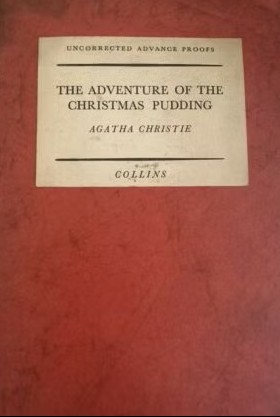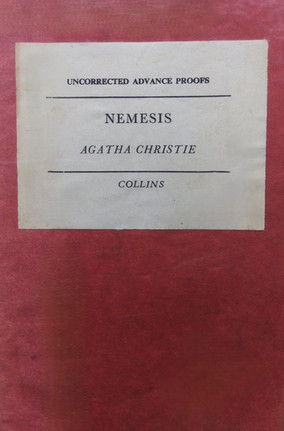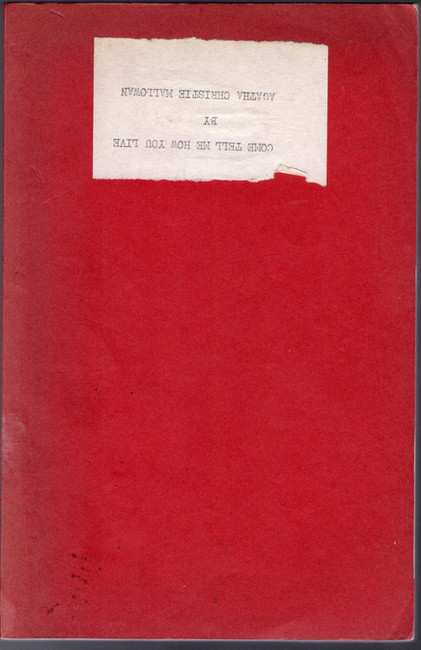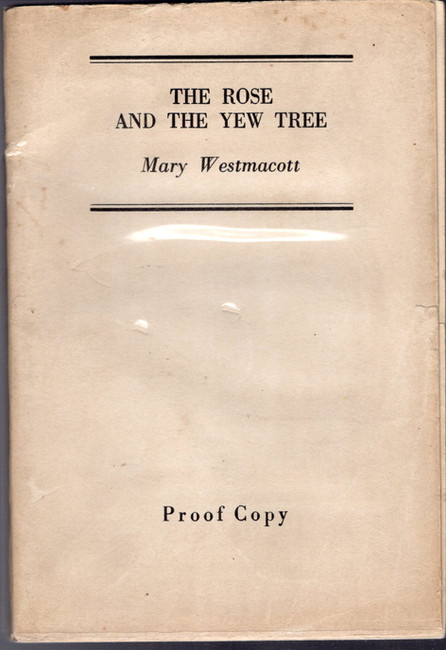Agatha Christie's British Review Copies
- David Morris

- Aug 30
- 11 min read
Updated: Sep 5
While a picture is worth a thousand words confirming the importance of cover art on books, a positive written review of any length in a newspaper or magazine is potentially worth thousands of books sold. This reality led to publishers providing copies of books prior to publication to media outlets that have the ability to influence sales. It also led to the advance distribution of books to books store and other vendors so that they knew what was going to be published in the months ahead, allowing for orders to be placed and promotions planned. These books are generally referred to as ‘Review Copies’ though they come in various guises. Many collectors of books enjoy searching for and acquiring these review copies for their own libraries.
In this article, I’ll look at the various forms of British Review Copies that are known to exist for Agatha Christie’s books. The variety of formats found in Britain is similar to what is found in other countries, some of which I may cover in future articles. Since there is no definitive catalogue of Review Copies that exist, this article will serve as a starting point to which I hope readers will add their own knowledge so that the article can be enriched with other entries. It is almost certain that a Review Copy in some format exists for every Christie book published. How they were marked, bound and published are the attributes that lack clarity.
It is important to be clear that Review Copies are distinctly different from Draft Copies and Galley Proofs. Draft manuscripts and typescripts were common before personal computers became widely used. These drafts were often sent between authors, editors and publishers, with numerous corrections and edits being made. Over my years of collecting Christie’s books, I’ve owned and handled a number of these draft copies. They are unique collectibles in their own right but did not serve the purpose of a Review Copy. Galley Proofs are one step closer to the final book, but are generally unformatted in preparation for internal editing and typesetting. Neither of these will be covered in this article.
The Types of Review Copies.
There are three common forms of Review Copies found for Agatha Christie’s British books which are as follows:
1. Marked First Editions. Both John Lane and Collins are known to have distributed first editions out to reviewers. In the early years examples exists where the books are solely marked with an embossed stamp on one of the pages that states ‘Review Copy’ or similar. It is likely some form of correspondence initially accompanied them, but I haven’t seen ephemera like this with a marked printing to review.
2. Advance Review Copies. Collins certainly provided these for many of their titles over the years. In earlier years they were referred to as a ‘Proof Copy’, then 'Advance Copy' and in later years as an ‘Uncorrected Advance Proof’. There are binding differences between these which are discussed below. John Lane provided these for later reprints, which they called 'Uncorrected Proof Copy'. It is unknown if they issued proofs in the 1920s.
3. Advance Reading Copies. These are typically just first edition books with no modifications or embossing but were sent out with a ‘Press Release’ or ‘Review Requested’ letter or note. At the foot of the article is an example from the 1950s.
Book Binding Variances.
Understanding the differences between how these Review Copies were produced and grounding in a common language will be helpful for collectors.
The internal pages of a hard-back book is called the ‘book block’ and for most of Christie’s life these were created by collating ‘Signatures’ (smaller sections of folded sheets that were stitched together). Once all the signatures were assembled in the correct order they become the book block.
First Edition printings then had endpapers and hard boards affixed to this block. This is often referred to as a ‘Case Binding’. This binding was then protected with a dust wrapper. Distribution of these books, potentially prior to official release, appears likely to have been the common approach in the 1920s and early 1930s.
Proof Copies produced by Collins usually exited production prior to the addition of end papers and hard boards. Instead, the spine of the collated signatures was roughened to enhance adhesion. A glue was then applied to this rough spine, and a softer wrap-around cardstock cover was affixed. This is generally called a ‘Sewn Paperback Binding’. These appear to have been more commonly used in the mid to late 1930s, 1940s and 1950s, and are exceptionally scarce.
Advance Uncorrected Proofs (AUP) produced by Collins often didn’t use collated signatures but solely glued the sequential pages directly to the cover’s spine. This is generally called a ‘Perfect Bound’ book. This is cheaper to produce but is a less durable book. AUPs often lacked all the details of a finished book. For example, if a Chapter Index is present, it likely did not have the page numbers assigned. These AUP versions appear to have been used in earnest from 1960 onwards and are much more common than the earlier Proof Copies.
Known British Review Copies.
1921: The Mysterious Affair at Styles, John Lane, The Bodley Head, London. A regular first edition hardback book but with an embossed stamp on the title page stating ‘Review Copy with John Lanes Compliments’ within an oval border (image below right, with the embossing to the right edge).

circa 1930: The Murder of Roger Ackroyd, The Detective Club (reprint), London. An advance copy of the reprint of this title published to capitalize on the film release of Alibi based on this novel.
1934: Murder on the Orient Express, Collins, The Crime Club, London. Published in blue soft covers with a label affixed. Printed single-sided (verso) only. Note: unseen by me – cited from a past auction.
1936: Cards on the Table, Collins, The Crime Club, London. Published in green soft covers with a label affixed. Note: unseen by me – cited from a past auction.
1939: Ten Little N_, Collins, The Crime Club, London. Rear text page of hardbound book is embossed with an oval stamp that reads ‘Review Copy / Collins’ (image below).

1946: Come, Tell Me How You Live (As Agatha Christie Mallowan), Collins, London. Known to exist as an Advance Reading Copy with Collins' request for a copy of the newspaper review, along with the publication details affixed to the flysheet.

1950: A Murder is Announced, Collins, The Crime Club, London. Published in cream white soft covers over hardback contents of stitched ‘signatures’ - thus a 'Sewn Paperback Binding'. The affixed label affixed states Collins Proof Copy, with the planned price of 8/6 and the anticipated publication date of June 5th, 1950 - which was accurate (image below).

1953: A Pocket Full of Rye, Collins, The Crime Club, London. Issued in a very tall stapled soft-cover format with an affixed label. Collins called this style a 'page proof' in the accompanying letter. A review slip was also provided with the book.
By 1955, Collins was affixing labels that used the wording 'Advance Copy' as seen on this Review Copy (below) for Alastair MacLean's H.M.S. Ulysses. Thus, I would expect that the sewn paperback bound Review Copies for Christie during the mid to late 1950s would also use this updated terminology.

1955: Mrs. McGinty's Dead, Pan Books Ltd, London. This Review Copy shows that paperback companies also created proofs or review copies. Published in soft white covers with black text printed on the cover. Pan called this an 'Uncorrected Proof' (image below left)
1960: The Mysterious Affair at Styles, The Bodley Head, London. While the book was originally published in the UK in 1921, this 'Uncorrected Proof Copy' shows that by this period The Bodley Head was issuing Review Copies. As with the Pan proof, I assume the primary purpose here was to review layout and formatting, as the text was already extant.
1960: The Adventure of the Christmas Pudding, The Crime Club, London. Referred to as an Uncorrected Advance Proofs edition, published in red soft covers, with the informational label glued onto the front cover (image above right). The book’s title was expanded when published as The Adventure of the Christmas Pudding and a Selection of Other Entrees.
1961: The Pale Horse, The Crime Club, London. Two forms of Review Copy are known.
(1) Referred to as an Uncorrected Advance Proofs edition, published in red soft covers, with the informational label glued onto the front cover. The copy I’ve seen also had a label from Juta & Company in Cape Town, South Africa (image below middle). Juta’s was an prominent publisher and bookseller in Cape Town that appears to have handled the distribution of Collins’ books in the region.
(2) An Advance Reading Copy is known to exist with unique boards (not the standard orange) and a dust wrapper with untrimmed flaps.
1963: The Clocks, Collins, The Crime Club, London. Advance Reading Copies known to exist (first editions with press letters).
1964: A Caribbean Mystery, Collins, The Crime Club, London. Referred to as an Uncorrected Advance Proofs edition, published in red soft covers.
1965: At Bertram’s Hotel, Collins, The Crime Club, London. Referred to as an Uncorrected Advance Proofs edition, published in red soft covers, with the informational label glued onto the front cover (image below left).
1965: Star Over Bethlehem and Other Stories, Collins, London. Referred to as an Uncorrected Advance Proofs edition, published in red soft covers with the title and information printed in black on the cover.
1966: Third Girl, Collins, The Crime Club, London. Published in red soft covers. First page after covers has promotional blurb and book excerpt (image above right).
1967: Endless Night, Collins, The Crime Club, London. Referred to as an Uncorrected Advance Proofs edition, published in red soft covers, with the informational label glued onto the front cover (image below left).
1968: By the Pricking of my Thumbs, Collins, The Crime Club, London. Referred to as an Uncorrected Advance Proofs edition, published in red softcovers.
1970: Passenger to Frankfurt, Collins, The Crime Club, London. Referred to as an Uncorrected Advance Proofs edition, published in red soft covers, with the informational label glued onto the front cover (image above middle).
1971: Nemesis, Collins, The Crime Club, London. Referred to as an Uncorrected Advance Proofs edition, published in red soft covers, with the informational label glued onto the front cover (image above right).
1972: Elephants Can Remember, Collins, The Crime Club, London. Referred to as an Uncorrected Advance Proofs edition, published in red soft covers, with the informational label glued onto the front cover. Note: Swann Galleries Auction House reportedly had a version in blue wraps though no image exists.
1973: Postern of Fate, Collins, The Crime Club, London. Referred to as an Uncorrected Advance Proofs edition, published in red softcovers.
1973: Akhnaton, Collins, London. Published in soft red covers but without any affixed label, but sold with a dust wrapper that would appear on the first edition. It is unclear if this was added at a later date.
1973: Poems, Collins, London. Published in soft red covers, seen with affixed label and also without (image above right).
1974: Poirot's Early Cases, Collins, The Crime Club, London. Referred to as an Uncorrected Advance Proofs edition, published in red soft covers with the gunman logo. By the mid-1970s, Collins was now printing the title and information in black on the cover rather than affixing a label (image below left).
1975: Poirot’s Last Case, Collins, The Crime Club, London. Referred to as an Uncorrected Advance Proofs edition, published in red soft covers (image below). Of note, the preliminary title on this Review Copy does not include ‘Curtain’.
1975: Come Tell Me How You Live, Collins, London. This is a revised edition of the original semi-autobiographical novel from 1946, and was published under her full name, Agatha Christie Mallowan. The Review Copy was issued in soft red covers with an affixed label - upside down on this example (below left).
1976: Sleeping Murder, Miss Marple's Last Case, Collins, The Crime Club, London. Referred to as an Uncorrected Advance Proofs edition, published in red soft covers with the title and information printed in black on the cover (image above right).
1977: An Autobiography, Collins, London. Two forms of Review Copy are known.
(1) Referred to as an Uncorrected Advance Proofs edition, published in red soft covers with the title and information printed in black on the cover (image below left). Page numbers not yet assigned and illustrations not documented.
(2) An Advance Reading Copy is also known to exist for this title distributed with a request for a review (images below middle and right).
1979: Miss Marple’s Final Cases, Collins, The Crime Club, London. Referred to as an Uncorrected Advance Proofs edition, published in orange soft covers with the title and information printed in black on the cover, along with the Crime Club gunman logo. The copyright page is undated (0000), and no page numbers are provided for the stories. This proof contained only 7 short stories, while the ultimate first edition included eight, adding ‘Miss Marple Tells a Story’. When published, the title became awkwardly Miss Marple's Final 6 Cases and 2 Other Stories.
Mary Westmacott Titles.
Review copies are also known to exist for Christie's books published under her pen-name Mary Westmacott. While these books were also published by Collins, the appearance of the Review Copies is quite different.
1948: The Rose and the Yew Tree, Collins, London. Referred to as a Proof Copy and issued with white soft covers and black printed text.
1956: The Burden, Collins, London. Referred to as a Proof Copy and issued with white soft covers and red printed text.
Market values.
Review Copies are not as widely collected as First Editions for a variety or reasons. These include lack of availability, lack of dust jackets, no direct connection with the books one actually read, and that in some cases titles and contents changed. Collectively this keeps valuations muted in many cases. However, Review Copies have appeal because they precede the actual first editions, are scarce and provide a unique connection to the publishing world of Agatha Christie. When one considers these competing aspects to their appeal, assessing the values of Review Copies is challenging. In addition, there are not a lot of recent auction records. Also, since they are quite uncommon pre-1960, the value realized in a sale may vary substantially based upon whether multiple collectors are seeking it at the same time. However, the following is likely close to accurate when trying to assess values.
1. Marked First Editions: Case bound with an embossed stamp present. The value is likely 5-10% more than a regular first edition in the same condition (including considerations for the jacket).
2. Proof Copies: In a ‘Sewn Paperback Binding’ without any cover art. These will mostly be from the mid-1930s to the 1950s. I’d expect most of these to sell within £1,000 - £5,000, depending on the appeal of the title.
3. Uncorrected Advance Proofs: in a ‘Perfect Bound’ format. These will mostly be from the 1960s and 1970s. I’d expect most of these to sell within £75 - £150 range, depending on the appeal of the title.
4. Advance Reading Copies: 0-5% more than a regular first edition in the same condition (including considerations for the jacket). However, if the Press Release or Review Letter is unique or has some direct connection to Christie’s inner circle, then a higher valuation would certainly occur.
Closing Comments.
Review Copies are not an area I personally collect, so images were provided by a variety of collectors, as well as historical auction records, and a few from current vendors. Thank you to Steve Chibnall who provided insights on the Collins 'Bob' novels from the 1930s - some of which were potentially thought to be Review Copies due to their 'sewn paperback bindings', but are now more firmly believed to be a cheaper way Collins used to sell their overstock. Also, thank you to the following collectors who provided some of the images and shared their own knowledge: David Murrills with Far North Books and Chuck Vukotich - who provided the initial encouragement for this article. Also, as noted earlier, if you own an Review Copy of a Christie book – British or Global – please do share details for either inclusion in this or a future article. I can be reached at collectchristie@gmail.com
Subscribe & the Socials.
If you are not a subscriber to my website, please consider subscribing here: link. This ensures you receive an email any time I write and post an article. Re: Social Media accounts - do consider following me on X (formerly Twitter) @collectchristie , on BlueSky @collectchristie.bsky.social and on Facebook. The content on X and BlueSky is usually identical, but will vary on Facebook. I am also now on Instagram. All should be of interest for any fan of Agatha Christie.
Happy Collecting!




























































Imagine Styles needing the subtitle A Detective Story so that everyone would know what it was. 😆